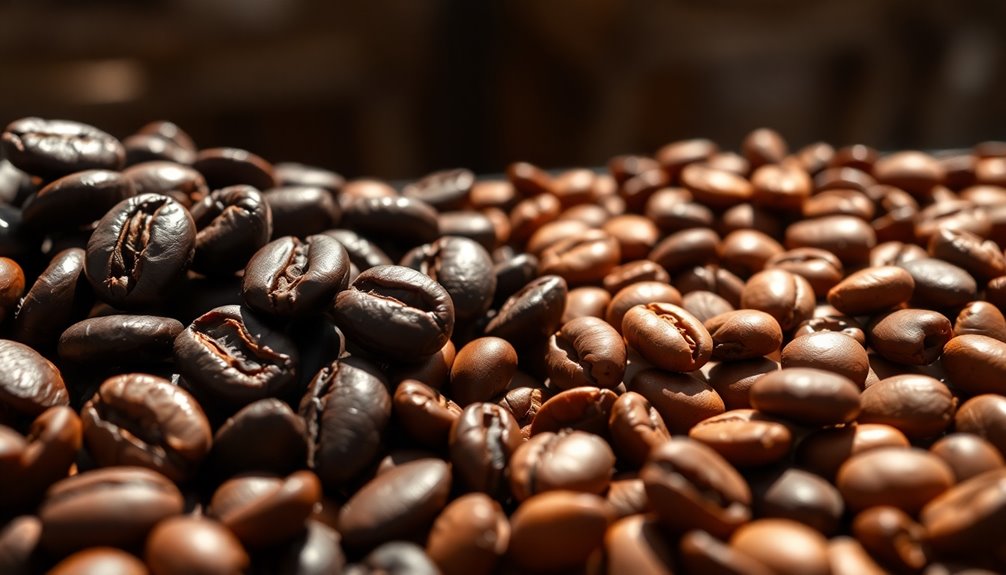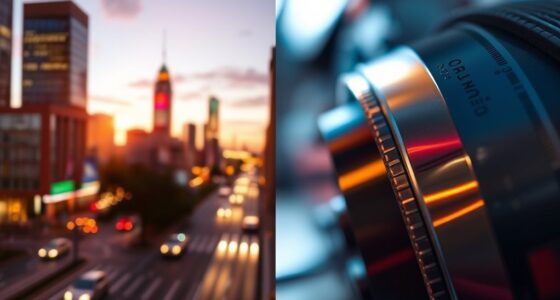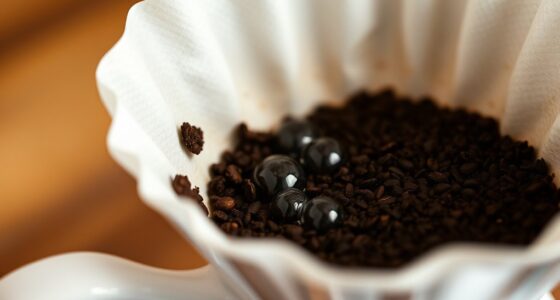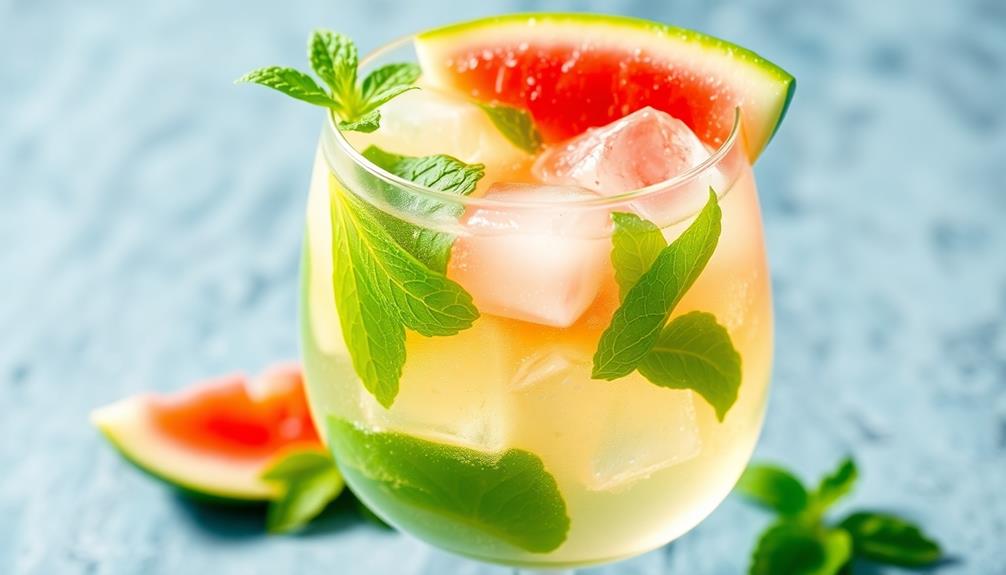Espresso beans and coffee beans differ mainly in roasting, flavor, and preparation. Espresso beans undergo a dark roast, giving you bold, rich flavors and more oils, perfect for high-pressure brewing. On the other hand, coffee beans are roasted lighter and are suited for various brewing methods like drip and pour-over. While you can use coffee beans for espresso, the taste won’t be the same. Want to learn more about their unique characteristics? Keep exploring!
Key Takeaways
- Espresso beans are dark roasted for bold flavors, while regular coffee beans are roasted to various levels, resulting in a range of flavors.
- Espresso requires a fine grind size for optimal extraction, whereas regular coffee beans are usually ground coarsely to prevent bitterness.
- Brewing espresso uses high pressure and takes 25-30 seconds, whereas regular coffee brewing methods take several minutes with more water contact.
- Espresso beans produce rich crema due to higher oil content, while regular coffee beans have lower oil levels, affecting crema formation.
- Dark roasted coffee beans can mimic some espresso flavors but may not perform well under high brewing pressure.
What Are Coffee Beans?
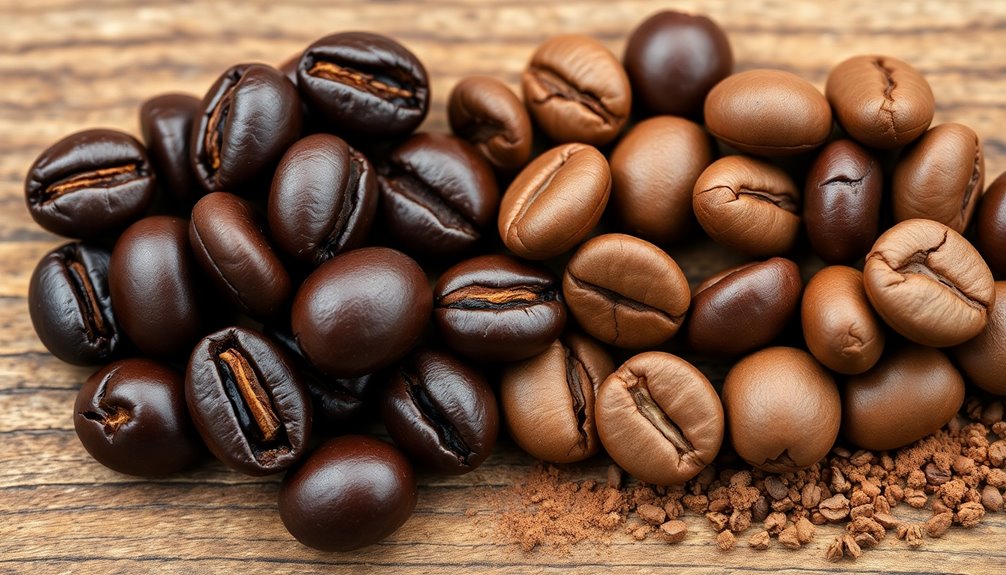
Coffee beans, the heart of your favorite brews, are actually the processed seeds of coffee cherries. These beans come primarily from two species: Arabica and Robusta.
Arabica beans are known for their smooth, complex flavors, while Robusta tends to be stronger and more bitter, appealing to different taste preferences.
The roast level of these beans can range from light to extra dark, influencing their unique flavor profiles, which may include fruity, nutty, floral, and chocolaty notes.
Various brewing methods, like drip coffee, cold brew, and pour-over, let you explore these flavors, making coffee versatile for your enjoyment. Understanding the differences between espresso and coffee helps you appreciate the rich world of coffee and choose the perfect brew for any occasion.
What Are Espresso Beans?
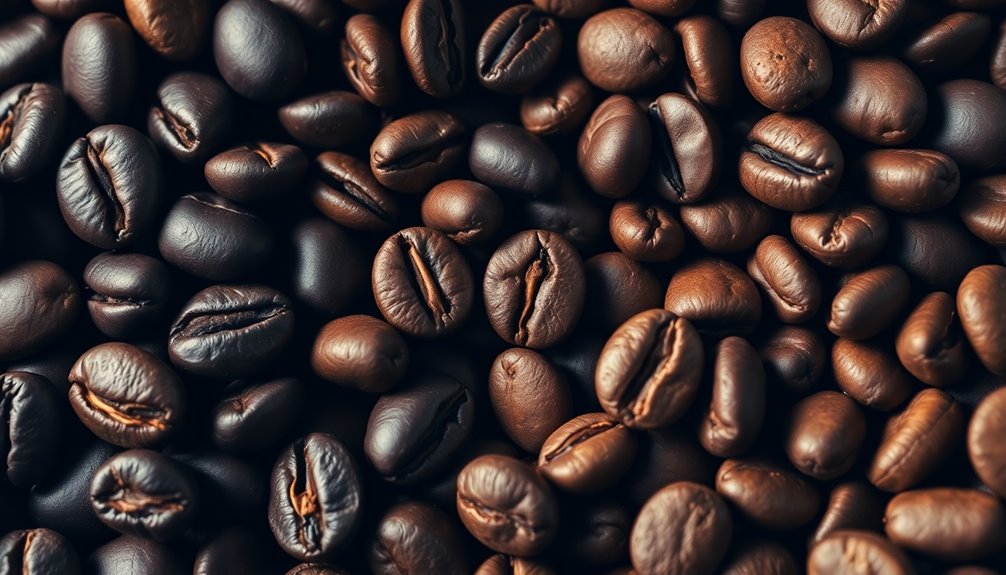
Espresso beans are dark roasted coffee beans crafted to deliver a bold flavor that stands up to high-pressure brewing.
Their unique roasting process enhances oil extraction, resulting in a rich crema that you’ll notice in every shot.
Understanding the roasting, flavor characteristics, and brewing methods will help you appreciate what makes espresso beans special. Additionally, the roasting process impacts the overall flavor profile and aroma of the coffee.
Roasting Process Explained
When you immerse yourself in the world of espresso, you’ll discover that the roasting process plays an essential role in shaping the beans’ unique characteristics.
Unlike regular coffee beans, espresso beans are roasted longer at higher temperatures, resulting in a dark roast that enhances their flavor profile. This extended roasting deepens the beans’ color and reduces moisture content, creating a lighter weight and more concentrated flavor in your brew.
The chemical changes during roasting develop rich aromas and flavors, often revealing notes of chocolate, caramel, and nuts. To achieve that perfect shot of espresso, these roasted coffee beans require a fine grind size, vital for producing the signature crema and that bold, concentrated flavor you crave. Additionally, the culinary uses of butter can be enhanced by pairing espresso with rich desserts, creating a delightful contrast in flavors.
Flavor Profile Characteristics
The unique qualities of espresso beans stem from their distinct flavor profile, developed through the dark roasting process. This roasting enhances the rich, bold taste you experience in espresso shots, setting them apart from regular coffee beans.
The higher concentration of natural oils formed during roasting contributes to the signature crema that tops your espresso. When ground to a fine size, espresso beans optimize flavor extraction during brewing, providing a deeper and more intense flavor.
You’ll notice notes of chocolate, caramel, and nuttiness, along with a lower acidity and thicker mouthfeel. These characteristics make espresso ideal for concentrated coffee beverages, delivering a robust experience that highlights the complexities of the espresso flavor profile. Moreover, coffee’s health benefits include antioxidants that combat oxidative stress, adding to the appeal of espresso as a flavorful and health-conscious choice.
Brewing Method Considerations
Espresso beans are dark roasted beans specifically prepared for use in an espresso machine. The brewing method for espresso involves high pressure and minimal water contact, which requires a fine grind of the beans to extract peak flavor.
This unique process creates concentrated coffee with a bold body and thick consistency. Unlike regular coffee beans that can be ground for different methods, espresso beans yield a distinct crema, enhancing both flavor and visual appeal. Additionally, the flavor profile of espresso can vary significantly based on the milkfat content used in the espresso preparation, similar to how different ice cream qualities affect taste.
Key Differences Between Espresso Beans and Coffee Beans
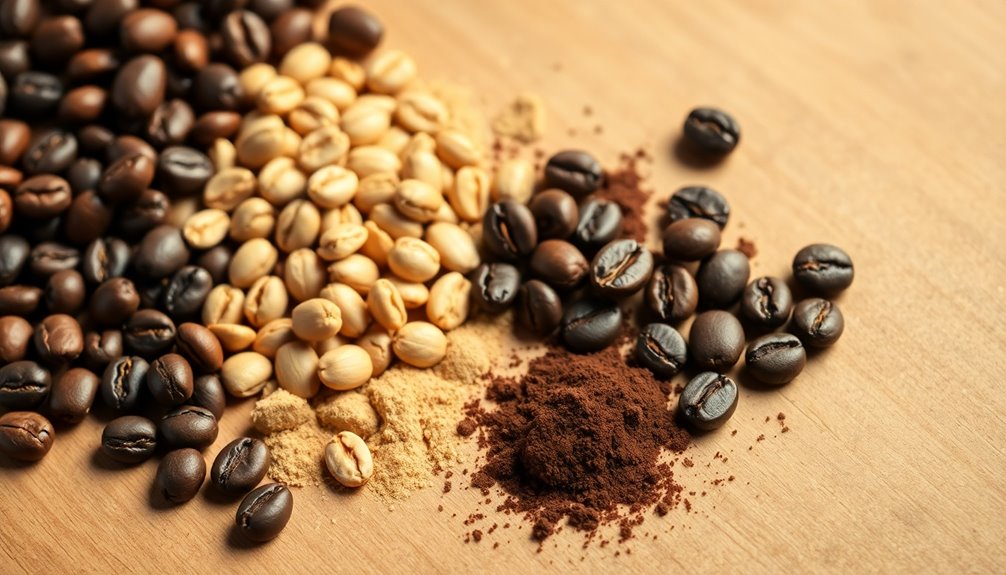
When it comes to espresso beans and coffee beans, the differences start with the roasting process.
You’ll notice that espresso beans are usually dark roasted, while coffee beans can be light or dark, impacting their flavors.
Additionally, how you brew each type also varies, leading to distinct experiences in every cup. The brewing method, such as using a French Press, can significantly influence the final taste and aroma of the coffee.
Roasting Process Variations
Although both espresso beans and coffee beans originate from the same plant, their roasting processes create distinct differences that greatly impact their flavor and characteristics.
Espresso beans are typically roasted longer at higher temperatures, resulting in a dark roast that enhances their bold flavor profile. This extended roasting leads to a noticeable oily sheen, which adds to the rich crema during brewing.
In contrast, coffee beans can be roasted to various levels, from light to dark, allowing for a broader range of tastes, like fruity or nutty.
Curiously, the longer roasting time for espresso beans results in lower caffeine content, even though espresso is often perceived as stronger due to its concentrated nature. Additionally, the brewing methods used for each type of coffee can further influence the overall experience and caffeine levels in the final cup.
Brewing Method Differences
Understanding the differences in brewing methods between espresso beans and coffee beans is essential for any coffee lover. Espresso beans are ground finely, maximizing oil extraction under high pressure, while coffee beans are coarser for methods like drip or French press. Espresso brewing relies on minimal water contact, producing a concentrated shot with bold flavors in just 25-30 seconds, whereas coffee brewing often takes longer, affecting flavor extraction. The choice of brewing method greatly impacts the concentration of flavors and bitterness in your cup, making it important to consider air fryer technology when exploring healthier cooking options.
| Feature | Espresso Beans | Coffee Beans |
|---|---|---|
| Grind Size | Medium-fine to fine | Coarse |
| Brewing Time | 25-30 seconds | Several minutes |
| Flavor Concentration | High | Medium |
How They Are Prepared
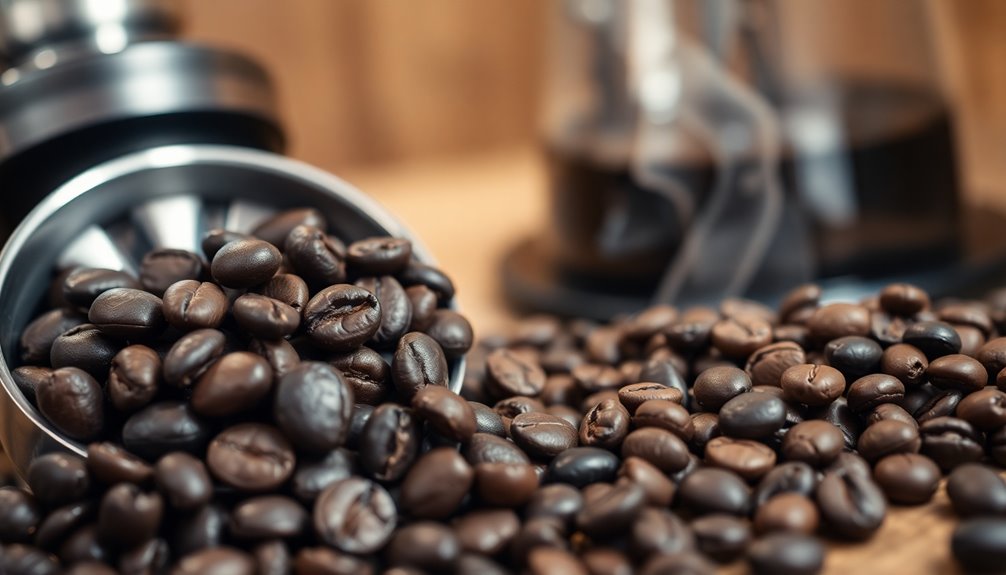
Espresso beans and coffee beans undergo distinct preparation processes that greatly influence their flavor profiles.
Espresso beans are roasted for a longer duration at high temperatures, resulting in dark roast coffee beans that are rich in oil and bold in flavor. This oil extraction contributes to the crema produced during brewing, enhancing your espresso experience.
Espresso beans undergo longer roasting, yielding rich, oily flavors and a delightful crema for an enhanced espresso experience.
In contrast, regular coffee beans are roasted for a shorter time, leading to lighter flavor profiles with varying taste characteristics.
When preparing coffee, you typically grind regular coffee beans coarsely for different brewing methods, while finely ground espresso beans maximize oil extraction.
These differences in roasting and grinding techniques create unique and distinct flavor profiles, setting espresso apart from regular coffee. Additionally, the brewing techniques used for espresso can further enhance its rich flavor compared to standard coffee brewing methods.
How They Are Ground
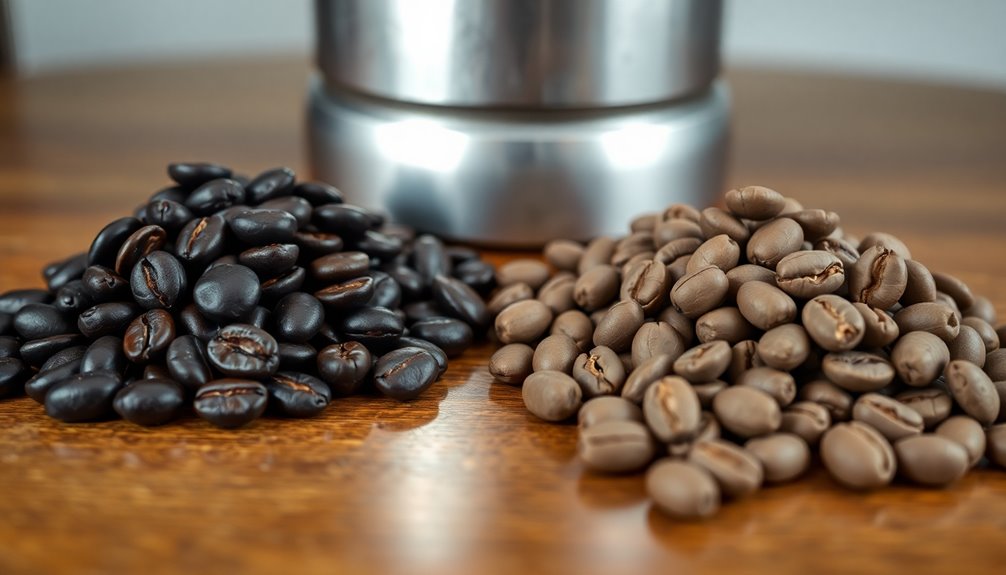
The grind size of coffee beans plays an essential role in determining the flavor and strength of your brew.
When you’re brewing, understanding the differences in grind size between espresso beans and regular coffee beans is vital.
Here’s what you need to know:
- Espresso beans are finely ground to maximize oil extraction for a rich flavor and crema.
- The grind size for espresso is usually medium-fine to fine, perfect for high-pressure brewing.
- Regular coffee beans are ground coarsely, which helps prevent over-extraction and bitterness.
- Finer grinds create more surface area, leading to faster extraction, while coarser grinds require longer brewing times.
Using the correct grind size is essential; too coarse a grind may lead to weak and under-extracted shots. Additionally, watering techniques can impact the overall flavor profile of coffee plants, as proper hydration is crucial for healthy growth.
Amount of Natural Oils
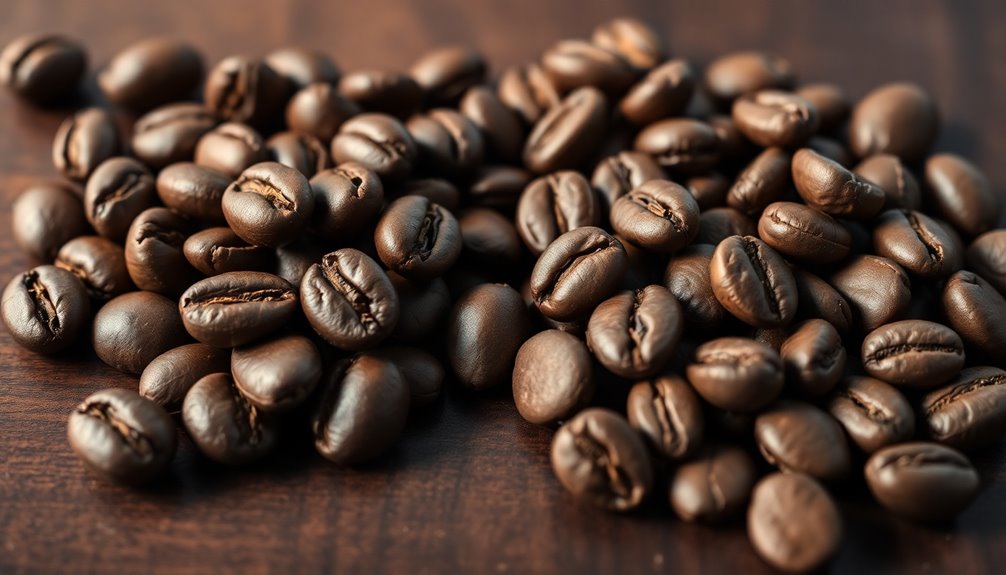
While exploring the differences between espresso beans and regular coffee beans, you’ll notice that the amount of natural oils plays an essential role in their flavor profiles.
Espresso beans are roasted longer, leading to a rich oil content that gives them a shiny appearance. These natural oils are crucial for creating the crema, that delightful golden frothy layer atop a well-prepared espresso shot.
Espresso beans undergo longer roasting, enhancing their oil content for a glossy finish and essential crema formation in every shot.
In contrast, regular coffee beans are roasted for shorter periods, resulting in less oil extraction and a lack of that shiny sheen.
Using coffee beans for espresso mightn’t deliver the same rich crema or bold taste, as their lower oil content doesn’t support high-pressure brewing methods as effectively, affecting the overall flavor profile you experience.
How They Are Used
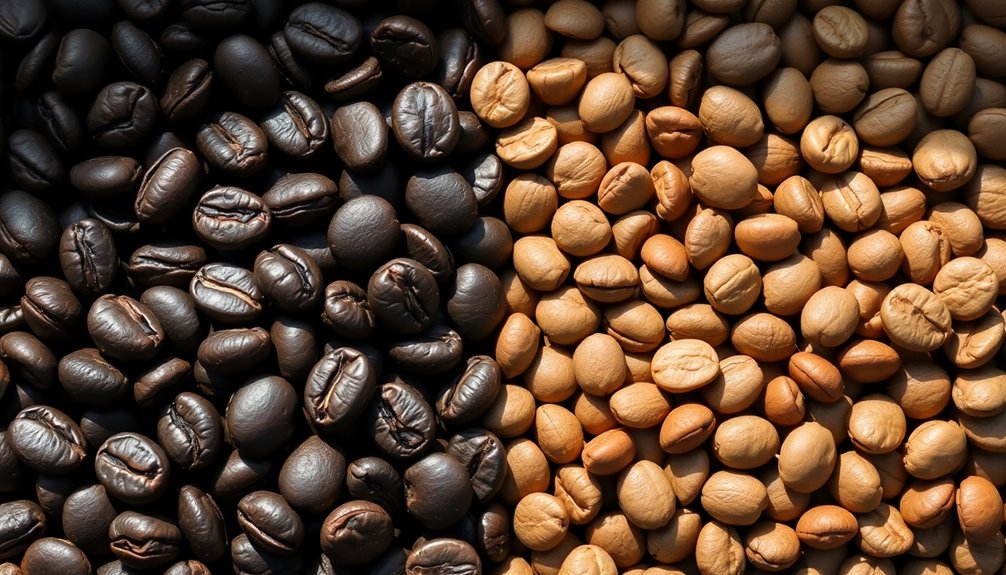
Understanding how espresso beans and regular coffee beans are used highlights their distinct roles in brewing.
Espresso beans are specifically crafted for high-pressure brewing methods, producing uniform, flavorful shots. Their high oil content enhances crema, enriching your espresso experience.
In contrast, coffee beans shine in various brewing methods like drip coffee, pour-over, and French press, where lighter roasting techniques bring out subtle flavors.
Here are four key uses:
- Espresso Beans: Ideal for high-pressure brewing, delivering concentrated flavor.
- Regular Coffee Beans: Suited for drip, pour-over, and French press methods.
- Crema Formation: Espresso beans contribute to a richer crema.
- Flavor Profile: Espresso beans offer a robust taste, while coffee beans provide a milder experience.
Can You Use Coffee Beans for Espresso?
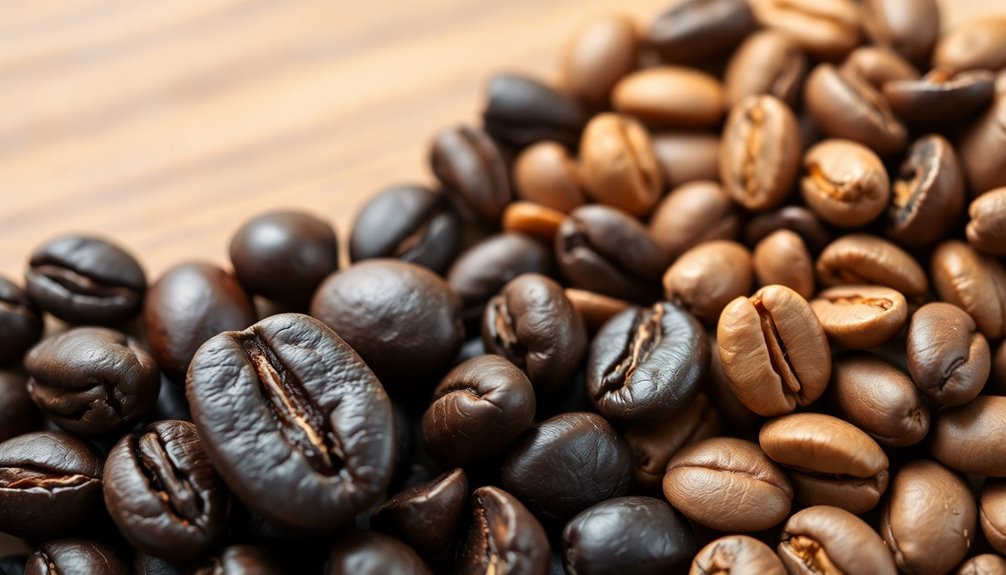
Can you really substitute regular coffee beans for espresso? While you can grind whole coffee beans for espresso-style drinks, the flavor profile will likely differ. Regular coffee beans may not handle the high brewing pressure required for espresso, affecting extraction and taste.
Here’s a comparison to take into account:
| Bean Type | Roast Level | Flavor Profile |
|---|---|---|
| Espresso Beans | Dark Roast | Rich, full-bodied |
| Coffee Beans | Light Roast | Tart and sour |
| Coffee Beans | Medium Roast | Balanced, but less bold |
| Coffee Beans | Dark Roast | Similar to espresso beans |
Experimenting with coffee beans for espresso can be fun, but for traditional results, it’s best to use beans specifically marketed for espresso preparation.
Choosing Between Coffee Beans and Espresso Beans
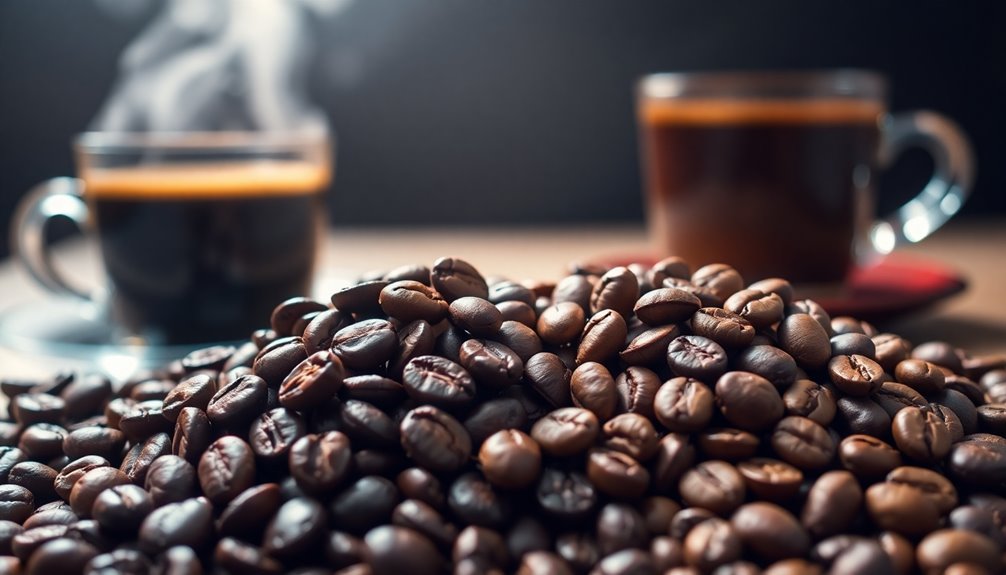
When deciding between coffee beans and espresso beans, what do you want to achieve with your brew?
Consider your brewing method and flavor preferences. Here’s a quick guide to help you choose:
- Bold Flavor: If you want a bold espresso shot, go for dark roasted espresso beans.
- Variety: For diverse flavors, coffee beans offer different types from light to extra dark roasts.
- Brewing Methods: Choose coffee beans for drip, pour-over, or cold brew; espresso beans suit high-pressure methods.
- Ground Size: For espresso-based drinks, use medium-fine or fine ground beans for ideal extraction.
Ultimately, espresso vs. coffee boils down to your brewing goals and taste preferences.
Choosing between espresso and coffee hinges on your brewing aspirations and personal taste.
Happy brewing!
Frequently Asked Questions
Are Espresso Beans the Same as Coffee Beans?
No, espresso beans aren’t exactly the same as coffee beans.
While they come from the same coffee cherries, their roasting and grinding processes differ. Espresso beans are usually dark roasted, which enhances their rich flavor and oily texture.
You’ll notice that they’re ground finer for the espresso brewing method.
Can I Use Any Coffee Beans for Espresso?
Yes, you can use any coffee beans for espresso, but you mightn’t get the flavor you expect.
Lighter or medium roasts can turn out tart or sour, while dark roasts offer that bold taste you usually want.
If you’re experimenting, keep in mind that the grind needs to be fine for the best extraction.
Freshly ground beans work best, so consider grinding them right before brewing for ideal results.
Can I Make Espresso With a Regular Coffee Maker?
You can’t make true espresso with a regular coffee maker.
Traditional coffee makers use drip methods that don’t create the high pressure needed for espresso.
While you might try using finely ground dark roast coffee to mimic espresso-like flavors, you won’t achieve the same richness or crema.
If you’re looking for a stronger brew, consider using a Moka pot or AeroPress instead, as they can produce a more concentrated coffee experience.
Can You Grind Coffee Beans for Espresso?
You can absolutely grind coffee beans for espresso, and it might just blow your mind!
While you can use regular coffee beans, keep in mind that the flavor mightn’t be as bold as with traditional espresso beans.
To achieve that rich, velvety shot you crave, grind those beans to a medium-fine consistency.
Don’t skimp on the grind size; it’s essential for extracting the flavors and creating that glorious crema.
Enjoy the process!
Conclusion
In the end, whether you choose coffee beans or espresso beans really comes down to your personal taste and brewing style. Both have unique characteristics that can elevate your coffee experience. Remember, it’s all about finding what tickles your fancy! So, don’t be afraid to experiment and mix things up. After all, variety is the spice of life! Immerse yourself, discover your favorites, and enjoy every sip of your caffeinated journey.
